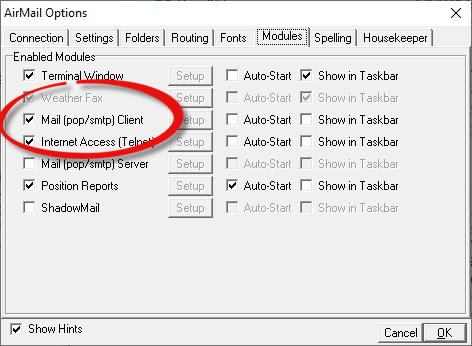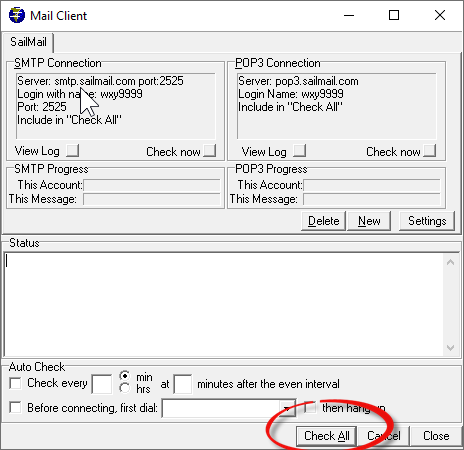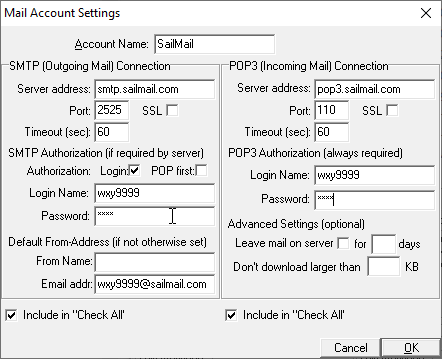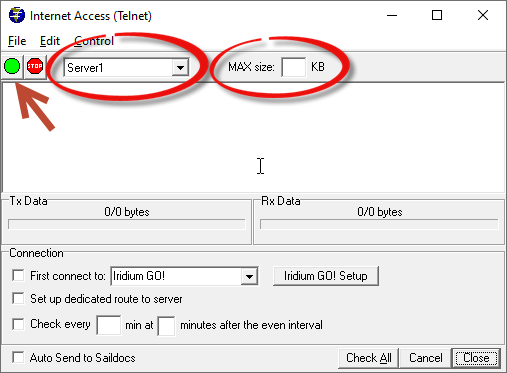“ShadowMail” is a Saildocs service which provides a method of monitoring a separate email account, and for downloading or forwarding messages as needed. This is available only to Sailmail members, and without charge.
The purpose of Shadowmail is to act as a bridge between your Sailmail address and whatever other email address you might use for regular email. The great advantage of Sailmail of course is that it works pretty much anywhere, but connection speeds are slow whether via radio or satellite. This means that you need to keep your Sailmail address private, and limited to friends and associates who understand not to send jokes, spam, etc.
We strongly recommend maintaining some sort of regular land-based email address for routine mail, on-line ordering, etc. This can be a regular personal or company email account, or a Hotmail, Yahoo or Gmail address for “public” use. These folks will keep your low-priority mail forever (Hotmail and Yahoo may require a small annual payment for this) until you can check mail from an internet-cafe. The problem of course is that folks sometimes send important messages to your regular address, and you have no way of knowing. Enter the Shadow…
Once you set it up, the Shadowmail server checks your regular email account a few times a day and sends you a summary of whatever new messages have arrived. Airmail decodes those “new mail” messages to maintain a “shadow” folder for each regular email account, showing the contents of that mailbox as a separate Airmail folder. For example, assume that you set up Shadowmail to monitor your Hotmail account. Then in addition to the usual “Inbox” and “Outbox” folders in Airmail, you would also have a “Hotmail” folder with a gray icon instead of yellow, indicating a “shadow” folder. When you open that folder you see a list of messages which are currently pending in your Hotmail account, showing from- and to-addresses, subject and date.
If you want to download one of those messages via Sailmail then right-click on that message and select “retrieve”. If you want to forward it to someone else (without downloading it) then right-click on it and select “Forward”. If you want to delete it without ever reading it, then right-click and select “Delete”. If you go to the local cyber-cafe and read and delete some of the Hotmail messages, then they will be removed from Airmail’s shadow-folder on the next update. The Hotmail shadow-folder will always match the contents of the Hotmail “inbox”.
To use Shadowmail a current version of Airmail is required, and you must be a Sailmail member. Shadowmail can be used via a radio connection, or via internet or satphone using Airmail’s Internet window. The first step is to read this document carefully and make sure that you understand the limitations. By using Shadowmail you are agreeing to the conditions contained here, and to the Saildocs terms and conditions (terms@saildocs.com).
To set up Shadowmail to monitor an email account, first enable Shadowmail and open the “Shadowmail Settings” window. Start by opening Airmail’s Options window (from the Tools menu), and then click on the “Modules” tab. Check the box to the left of “Shadowmail” (if not already checked) and click the “Setup” button to open the settings window.
Initially this “Shadowmail Setup” window is empty, click “New” to create a new account and give it a name. Then enter the server-address (the internet address of the “POP3” server), the login name and the password for the email account that you want to “shadow”. (This is NOT your Sailmail login, you need to get the server, login-name and password from the outfit that handles the email account that you want to monitor). Make sure “Account Active” is checked, and then click OK. Airmail will send a settings-message to the server and it will start monitoring your account. Mail is checked every 6 hours and you will get a message from the server (“shadow-reply@saildocs.com”) whenever new mail is received into that account.
Shadowmail can check any POP3 mail account, such as a business or regular Internet account. The Internet provider will supply the server address, login name and password. Keeping your mailbox tidy will make it easier to keep track of things. A good technique is to wait until you have Internet access at a marina and then retrieve everything you want to save to Airmail and delete it from the server. Alternately you can forward messages from the Shadow folder to another account, such as Hotmail or Gmail for safekeeping.
Here’s how some accounts are handled. For any of these you will need internet access to get things set up.
Microsoft Hotmail / Outlook / Live / Office365: POP3 access is provided to all Microsoft email accounts, but the “Premium” (paid) service may be required. Use the server-name “outlook.office365.com” (hotmail.com, pop3.live.com, pop-mail.outlook.com also work). Use your complete email-address as the login name, and you can use your normal password. However the first time that Shadowmail connects it will be blocked. To allow the connection go to your Microsoft mail settings and select “Security” (may be under “Premium”), and view “Recent Activity”. If Shadowmail was blocked then you see an entry there, check the time-stamp and click “That was me”.
If you have Microsoft’s “Two-step Verification” enabled then you will need to use an “App Password”, also under the Security tab. Use that in place of your normal password in Shadowmail settings.
Yahoo: Free Yahoo accounts also support POP3 access, and requires an “App Password”. You may also want the paid service which provides additional storage and avoids deactivation. Use the server-name “pop.mail.yahoo.com”, the login name is your Yahoo email address, and for password you need an “App Password” (search Yahoo help for “Generate app password). Note that 2-step verification is NOT required for an app password. Again, keep your inbox tidy by moving messages that you want to keep into other folders, and deleting the others.
Google Gmail: Shadowmail can also check Gmail accounts, but Gmail is a little “quirky”. Open Gmail settings (gear-icon, then “See all settings”), click on “Forwarding and POP/IMAP”, and select “Enable “POP for all mail”. Selecting “all mail” and using the “recent:” prefix (below) selects all messages received within 30 days. You will also need an “App Password” for Shadowmail, which requires 2-step verification. Those are found on your Gmail “Security” page, under “Signing in”.
In Shadowmail settings the server name is “pop.gmail.com”, login name is “recent:” followed by your complete GMail email-address (i.e. “recent:username@gmail.com”), and for password enter the App Password that you created for Shadowmail. For more details send a (blank) email to shadow-gmail@saildocs.com or see the web page at https://sailmail.com/shadowmail-checking-gmail-accounts/
AOL: AOL has added POP3 access and Shadowmail can check AOL accounts. The server is “pop.aol.com”, the login-name is your AOL “screen name”, and the password is your AOL login password. The server may occasionally return a “timeout” error, double-check the server-name and don’t worry, Shadowmail will keep trying.
For any email account: if you get back an error-message then double-check the POP3 server-address. Make sure the login name is correct, sometimes it is just your email name, or it may be the complete email address, or perhaps something completely different. Check the support information for the folks who provide the account, they will need to supply that info.
For accounts that have both a free and paid version, check what features are included. generally paid accounts offer more storage, don’t de-activate if the account is not used, and in some cases POP3 access requires a paid account.
Also remember that Shadowmail has to check everything in your Inbox folder whenever it checks mail. So it is important to keep things tidy by moving messages that you want to save into “archive” folders and deleting the rest. Create new folders for specific topics (or by year, for example) and move messages that you want to save into those folders for safekeeping after you have reviewed them.
You can also set up Shadowmail rules that will forward specific messages to your Sailmail address whenever they are received. For example, you can set up Shadowmail to forward anything with “urgent” in the Subject-line, and then give your business-associates your Hotmail address and tell them to include that word in the message-subject if they need an immediate reply. They don’t have your Sailmail address, but you can still be in touch- and in control. These “rules” are part of Airmail’s Shadowmail settings window, and can include two different checks, for example sender contains “mom” and size less-than 2000.
Replies that you send for messages which were retrieved by Shadowmail will of course be sent via Sailmail’s servers, and would normally come from your Sailmail address and with the how-to-reply footer added to the bottom. However if you are replying to a message which was retrieved via Shadowmail, then Airmail should substitute that reply address. Check this, however, and if you don’t see the “From” box in the message header then select the Message Menu, “Show From-Box”. A new box appears, enter the address that you want your email to be sent from.
Also, to suppress the Sailmail footer, add a line at the bottom of your message which says “short-footer” (without quotes) for a one-line footer “radio email processed by SailMail” and web-address) or “no-footer” for no footer at all. This should be on the last line, by itself, without quotes.
Some caveats and limitations: Shadowmail normally only sends a notice for new messages, not the entire mailbox. But when the account is first set up then the whole mailbox is indexed, and this can be large. If you have a lot of pending messages then try to do this via internet, not radio. Also, remember that the Shadowmail server must download the index for the entire mailbox whenever checking mail, this gets time-consuming if there are a lot of pending messages. The current limit is 1,000 pending messages, this may be adjusted up or down if needed. It is convenient to use the web-based mailboxes (Hotmail, Yahoo, GMail, etc.) as message-archives, but move messages to other folders and don’t keep them in the “inbox”. You won’t be able to use Shadowmail if there are too many messages in the inbox.
Also be careful and selective about setting up an automatic retrieval, and never set up Shadowmail to retrieve everything. Remember that the headers are always sent, and you can retrieve any message- the only reason for automatic retrieval is for messages that you are sure you want, so be selective.
Saildocs is a service of the Sailmail Association. For more information about Saildocs, send a (blank) email to: info@saildocs.com (or see the website at www.saildocs.com/info).
Please send questions about Shadowmail or Saildocs to: support@sailmail.com
Good sailing, Jim
(updated 2021-07-15)





